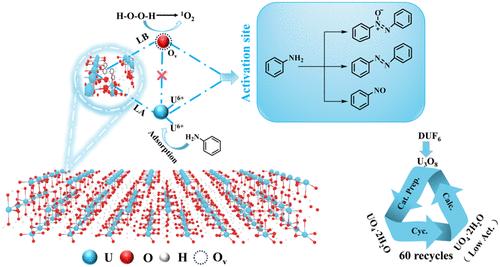贫铀废料中的UO4·2H2O:可再生固体FLP催化剂用于选择性苯胺氧化的可忽略放射性
IF 13.1
1区 化学
Q1 CHEMISTRY, PHYSICAL
引用次数: 0
摘要
作为核能生产的副产品,贫铀(DU)的积累引起了重大的环境问题。将贫铀转化为功能催化剂是一种很有前途的资源增值策略。在此,我们报道了一种基于238u的催化剂UO4·2H2O,放射性可忽略,由duf6衍生的α-U3O8通过溶解-沉淀法合成,可以通过溶剂调节将苯胺选择性氧化为亚硝基苯、偶氮苯和偶氮氧苯。结构和力学研究表明,表面缺陷是由受挫刘易斯对(FLPs)形成的。它的Lewis酸性U6+位增强了U = O键,缩短了U = O键的长度,增强了吸电子能力,促进了苯胺的吸附,而碱性氧空位位促进了H2O2的活化和单线态氧的生成,从而促进了苯胺的氧化。值得注意的是,该催化剂可通过煅烧-再沉淀再生60次,其e因子远低于精细化学基准。这项工作为DU增值提供了一个可扩展的策略,并为含氮精细化学品的合成提供了一个实用的平台。本文章由计算机程序翻译,如有差异,请以英文原文为准。

UO4·2H2O from Depleted Uranium Waste: A Regenerable Solid FLP Catalyst with Negligible Radioactivity for Selective Aniline Oxidation
The accumulation of depleted uranium (DU), a byproduct of nuclear energy production, poses significant environmental concerns. Converting DU into functional catalysts represents a promising strategy for its resource valorization. Herein, we report a 238U-based catalyst, UO4·2H2O, with negligible radioactivity, synthesized from DUF6-derived α-U3O8 via a dissolution–precipitation method, enabling selective oxidation of aniline to nitrosobenzene, azobenzene, and azoxybenzene by solvent tuning. Structural and mechanistic studies reveal that surface defects form frustrated Lewis pairs (FLPs). Its Lewis acidic U6+ sites strengthen the U═O bond and shorten its length, enhancing electron-withdrawing ability and promoting aniline adsorption, while the basic oxygen-vacancy sites facilitate H2O2 activation and singlet oxygen generation, thereby promoting aniline oxidation. Notably, the catalyst is regenerable via calcination-reprecipitation for up to 60 cycles, with an E-factor well below the fine chemical benchmark. This work provides a scalable strategy for DU valorization and a practical platform for the synthesis of nitrogen-containing fine chemicals.
求助全文
通过发布文献求助,成功后即可免费获取论文全文。
去求助
来源期刊

ACS Catalysis
CHEMISTRY, PHYSICAL-
CiteScore
20.80
自引率
6.20%
发文量
1253
审稿时长
1.5 months
期刊介绍:
ACS Catalysis is an esteemed journal that publishes original research in the fields of heterogeneous catalysis, molecular catalysis, and biocatalysis. It offers broad coverage across diverse areas such as life sciences, organometallics and synthesis, photochemistry and electrochemistry, drug discovery and synthesis, materials science, environmental protection, polymer discovery and synthesis, and energy and fuels.
The scope of the journal is to showcase innovative work in various aspects of catalysis. This includes new reactions and novel synthetic approaches utilizing known catalysts, the discovery or modification of new catalysts, elucidation of catalytic mechanisms through cutting-edge investigations, practical enhancements of existing processes, as well as conceptual advances in the field. Contributions to ACS Catalysis can encompass both experimental and theoretical research focused on catalytic molecules, macromolecules, and materials that exhibit catalytic turnover.
 求助内容:
求助内容: 应助结果提醒方式:
应助结果提醒方式:


